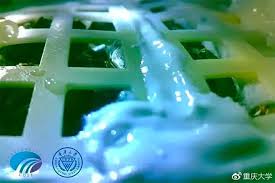
Breaking News
 Grand Theft World Podcast 257 | Foreign Affairs with guest Ernest Hancock
Grand Theft World Podcast 257 | Foreign Affairs with guest Ernest Hancock
 You've Never Seen Tech Like This
You've Never Seen Tech Like This
 Supreme Court Won't Exempt California Schoolchild From Vaccination Mandate
Supreme Court Won't Exempt California Schoolchild From Vaccination Mandate
 Visualizing the abundance of elements in the Earth's crust
Visualizing the abundance of elements in the Earth's crust
Top Tech News
 3D Printed Aluminum Alloy Sets Strength Record on Path to Lighter Aircraft Systems
3D Printed Aluminum Alloy Sets Strength Record on Path to Lighter Aircraft Systems
 Big Brother just got an upgrade.
Big Brother just got an upgrade.
SEMI-NEWS/SEMI-SATIRE: October 12, 2025 Edition
 Stem Cell Breakthrough for People with Parkinson's
Stem Cell Breakthrough for People with Parkinson's
 Linux Will Work For You. Time to Dump Windows 10. And Don't Bother with Windows 11
Linux Will Work For You. Time to Dump Windows 10. And Don't Bother with Windows 11
 XAI Using $18 Billion to Get 300,000 More Nvidia B200 Chips
XAI Using $18 Billion to Get 300,000 More Nvidia B200 Chips
 Immortal Monkeys? Not Quite, But Scientists Just Reversed Aging With 'Super' Stem Cells
Immortal Monkeys? Not Quite, But Scientists Just Reversed Aging With 'Super' Stem Cells
 ICE To Buy Tool That Tracks Locations Of Hundreds Of Millions Of Phones Every Day
ICE To Buy Tool That Tracks Locations Of Hundreds Of Millions Of Phones Every Day
 Yixiang 16kWh Battery For $1,920!? New Design!
Yixiang 16kWh Battery For $1,920!? New Design!
 Find a COMPATIBLE Linux Computer for $200+: Roadmap to Linux. Part 1
Find a COMPATIBLE Linux Computer for $200+: Roadmap to Linux. Part 1
A Chinese engineer reveals how he grew the FIRST EVER plant on the MOON using a mini-biosphere...

This week at London's Design Museum, one of the engineers behind the historic Chang'e-4 mission to the moon gave a demonstration of the spacecraft's 'mini-biosphere' where he and his team helped germinate the first seed ever on the moon.
The presentation, delivered by Xie Gengxin of Chongqing University, was part of the museum's 'Moving to Mars' exhibit showcasing a range of different technologies that will allow humans to survive long term in space and on other planets.
While previous groups had grown small plants on the International Space Station, which is in orbits the Earth some 250 miles above the surface, no one had yet accomplished the feat on the moon.
Xie and his team devised a cylindrical garden capsule to try and bring gardening deeper into outer space.
The capsule stood around 8 inches tall with a 6.5 inch diameter and had a rectangular seed bed that was loaded with cotton, potato, rape seeds, a variety of weed called Arabidopsis, and fruit fly eggs.



